June 26, 2025 | 12:28 GMT +7
June 26, 2025 | 12:28 GMT +7
Hotline: 0913.378.918
June 26, 2025 | 12:28 GMT +7
Hotline: 0913.378.918
Dong Nai has the highest forest coverage rate in the southern region, with 172,000 hectares of forest, comprising 123.7 hectares of natural forest and 49 hectares of planted forest. It establishes many strategies to capitalize on the economic growth potential under the forest canopy for both protection and production forests.
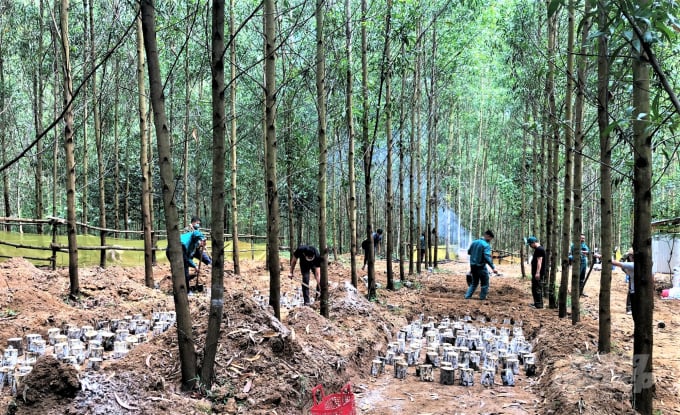
Dong Nai forestry industry is actively researching and adopting many economic development models under the forest canopy. Photo: Minh Sang.
According to the Dong Nai Department of Agriculture and Rural Development, the province has around 100 hectares of specialist protective forest that remains untapped due to the economic potential under the forest canopy. Over the years, the province has maintained and developed the "treasure," while also pursuing solutions that achieve a balance between economic usage and conservation. As a result, the economic plan must be long-term, sustainable, and considerate.
Mr. Le Van Goi, the department's deputy director, stated that the province's forestry industry is proactive in developing and implementing a variety of under the forest canopy economic models (UFCEMs) that provide practical advantages. He also stated that Dong Nai Nature and Culture Conservation Area has been allowed by the Department of Science and Technology to carry out the project of developing a nectarine trial planting model. This unit is currently under construction and is projected to be finished by the end of 2025.
"While we have taken on the duty of conserving the forest's water resource, the enormous economic potential under the forest canopy has yet to be tapped, and the cultivation of herbal trees under the forest canopy remains scattered and inefficient.
Foresters continue to be confused in their attempts to improve the forest economy. The cooperative model of growing lingzhi mushrooms under the forest canopy using clean hybrid acacia trees is a way to diversify forest products, increase economic efficiency, and promote sustainable forests ", Mr. Le Van Goi noted.
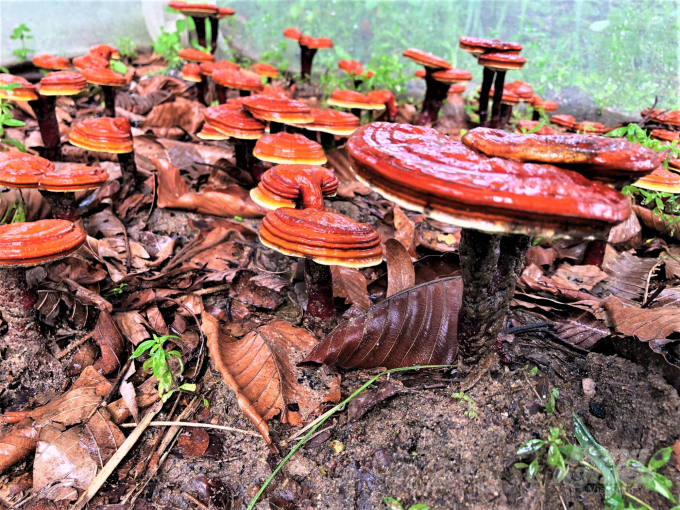
Some models of combined cultivation of lingzhi mushroom under the forest canopy have given very good results in Dong Nai. Photo: Minh Sang.
Several UFCEMs have been undertaken in the past, including planting Syzygium nervosum, polyscias fruticosa, mint, and turmeric beneath the forest canopy. Several locations have also begun to develop and market unique and attractive kinds of tourism, using the advantages of woods.
The Agricultural Service Center of Xuan Loc district has piloted three planting types that initially produce positive results. However, economic growth under the forest canopy has not yet captured the attention of foresters owing to a number of obstacles, including the absence of a suitable model for local plant conditions; a shortage of irrigation water; expensive investment costs for production; and unstable product output.
Indeed, the State, MARD, and localities with significant forest areas have explored and advocated developing economies under the forest canopy. Depending on the features of each area and forest type, the economy under the forest canopy can be heavily exploited in a variety of businesses, including tourism, livestock production, and planting and production of medicinal plants. Currently, the thought is centered on maintaining forest regions, efficiently utilizing forest products, and planting and growing additional forest areas "preserved" for the future...
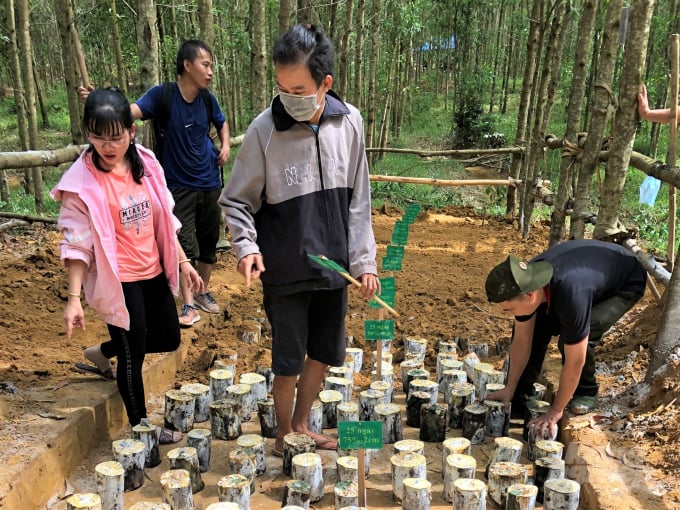
Dong Nai is building many economic models under the forest canopy, diversifying livelihoods for people. Photo: Minh Sang.
Over the last year, economic activity beneath the forest canopy has not been sufficient to draw the attention of forest owners and planters. The reason for this is that several problems remain; a lack of adequate models, a scarcity of irrigation water supplies, high investment costs, uncertain product production, and a lack of regulations to support these specialized economic activities... To conserve and enhance sustainable forest economic growth, it is required to develop and utilize forests in a multifunctional and multivalued manner, taking into account the potentials and benefits of each subregion and locale.
The Agricultural Service Center of Xuan Loc district (Dong Nai) Management Board reported that it has been appointed to manage over ten hectares of forest and forestry land, mainly planted forest areas. The unit has contracted with over 2,200 people in the Xuan Loc area to provide over 7,000 hectares of forest, including a portion of acacia hybrid forest. The economic value of forest land remains low, averaging around VND 20-25 million per hectare each year.
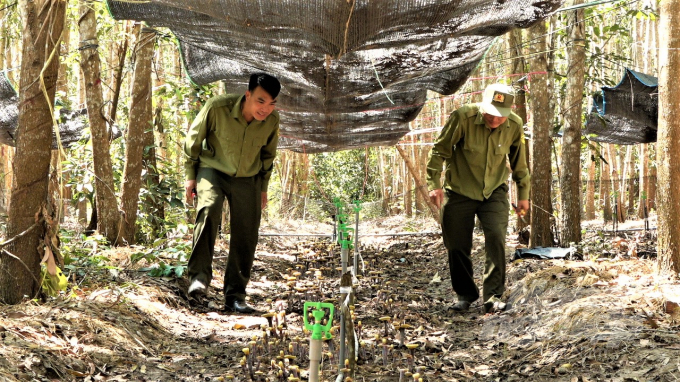
The Xuan Loc Protection Forest Management Board actively applies many models to both ensure the right purposes in using forest land and increase revenue for forest growers. Photo: Minh Sang.
Mr. Hoang Dinh Long, the unit's director, stated that the unit inked a cooperation agreement with THE VOS Ecosystem Company (Dong Thap province) to cultivate herbal mushrooms under the canopy to generate revenue for the community. The collaborative effort to grow herbal mushrooms under the forest canopy will utilize just the land beneath.
According to Mr. Long, the Management Board has arranged to deploy on the area of concentrated acacia hybrid forest produced directly by the unit shortly. The experimental planting of lingzhi mushrooms under the forest canopy in the vicinity originally showed that it was highly successful, adaptable to local soil and climatic conditions, and made efficient use of existing forest acreage. Simultaneously, rising income for forest farmers, lowering forest maintenance expenses and generating jobs for the local people...
THE VOS will collaborate with the Management Board of the Agricultural Service Center in Xuan Loc district to conduct an investment project including the planting of lingzhi mushrooms beneath the canopy of hybrid acacia trees on an initial area of around 230 hectares. Participants will be provided with mushroom types, technical assistance, and assurance of production output. Lingzhi mushrooms planted under the forest canopy are predicted to provide an income of around VND 200 million/ha in eight months, with a profit of approximately VND 70 million/ha. The concept has several practical benefits in terms of economy and ecology, assisting in more sustainable forest management and development.
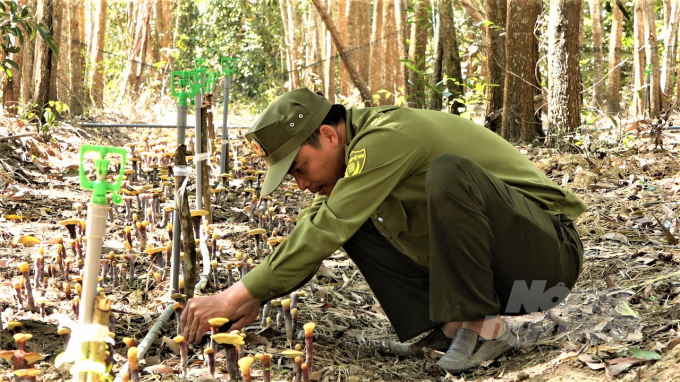
The results of trial planting of lingzhi mushroom under the forest canopy have initially shown that it is very effective, suitable for local soil and weather conditions. Photo: Minh Sang.
Mr. Tran Thanh Sang, General Director of VOS HARVEST Agro-Forestry Company and Project Development Manager of THE VOS Ecosystem Company, stated that acacia hybrids are termed "poverty reduction trees" since they are harvested as early as the fifth year after plantation. When forest trees are taken early, they are sold only as firewood at a significantly lower price than trees cut after the eighth year of growth.
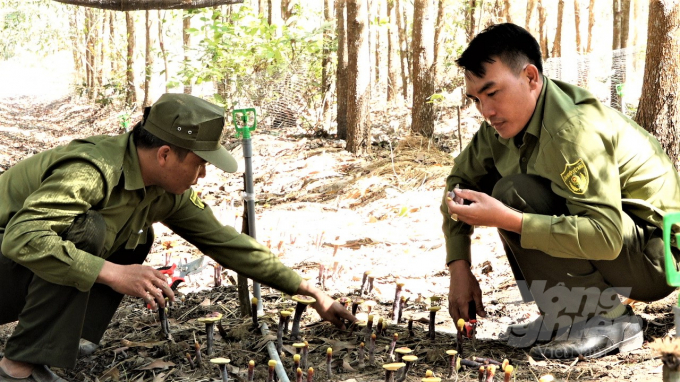
The company will associate to ensure the production and consumption of lingzhi mushrooms for farmers. Photo: Minh Sang.
The primary benefit of the model of growing lingzhi mushrooms beneath the forest canopy is that it provides additional income for forest growers, allowing them to stay longer in the forest. "Lingzhi mushrooms planted beneath the forest canopy will be purchased and exported by our company to Japan and several other countries. The project's objective will be expanded to include forest growers. Additionally, the firm will provide seed sources, transfer processes, and planting technologies to farmers, as well as sell products to them "Mr. Sang stated.
"We anticipate collaborating in the implementation of a model for producing herbal lingzhi mushrooms under the forest canopy, therefore contributing to conservation efforts and developing goods that benefit people's health." The primary objective of companies is for people and forest producers to collect at least VND 200 million per hectare every year. We expect that in the long term, Vietnam will not be the world's largest exporter of chopped wood but focus on developing a model of large-scale timber afforestation and export of high-value timber instead" said Dr. Le Hoang The, Chairman of THE VOS Ecosystem Company's Board of Directors.
Translated by Linh Linh
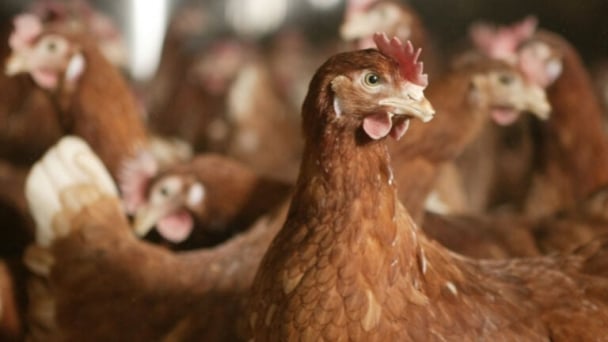
(VAN) Research has shown that Hy-Line brown hens may be better suited for cage-free production based on overall greater egg production and other quality metrics.
![Turning wind and rain into action: [9] Digitizing hydrometeorological data in response to climate change](https://t.ex-cdn.com/nongnghiepmoitruong.vn/608w/files/news/2025/06/17/z6704423696987_15fd32ffc26d590d204d520c9dac6786-nongnghiep-165943.jpg)
(VAN) Farmers have begun accessing hydrometeorological applications to adjust their cropping schedules, aiming to ensure productivity and adapt to climate change.
![Turning wind and rain into action: [8] Real-time salinity detection and early warning technology](https://t.ex-cdn.com/nongnghiepmoitruong.vn/608w/files/news/2025/06/17/z6704423696987_15fd32ffc26d590d204d520c9dac6786-nongnghiep-151127.jpg)
(VAN) Thanks to the integration of modern hydrological-hydraulic models, remote sensing technologies, and artificial intelligence, the accuracy of hydrological forecasting has significantly improved.
![Turning wind and rain into action: [7] Early disaster warnings help marine farmers minimize losses](https://t.ex-cdn.com/nongnghiepmoitruong.vn/608w/files/news/2025/06/17/z6704423696987_15fd32ffc26d590d204d520c9dac6786-nongnghiep-142942.jpg)
(VAN) In recent years, thanks to early disaster warnings and forecasting, marine farmers in Khanh Hoa province have been able to reduce risks and losses, thereby improving production efficiency.
![Turning wind and rain into action: [6] ‘Four on-the-spot’ disaster management software](https://t.ex-cdn.com/nongnghiepmoitruong.vn/608w/files/news/2025/06/17/e5a48259d6a262fc3bb3-nongnghiep-183800.jpg)
(VAN) By simply activating the scenario on the disaster management software, the relevant authorities immediately know how many households need to be evacuated, where to evacuate them to, and by what means of transportation…
![Turning wind and rain into action: [5] Hue applies modern technology in disaster forecasting](https://t.ex-cdn.com/nongnghiepmoitruong.vn/608w/files/news/2025/06/17/z6704423696987_15fd32ffc26d590d204d520c9dac6786-nongnghiep-093938.jpg)
(VAN) In Hue city, modern technology has recently been applied in meteorological and hydrological forecasting and warning, helping to reduce the damage caused by natural disasters.

(VAN) A cutting-edge farming technique being implemented on an experimental ranch in Arizona's Sonoran Desert has already saved a billion gallons of water over five years, according to Civil Eats.